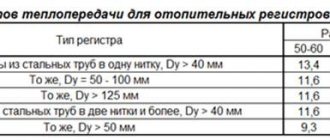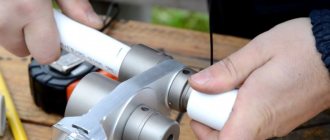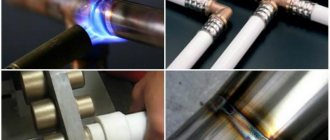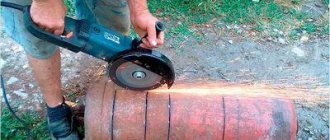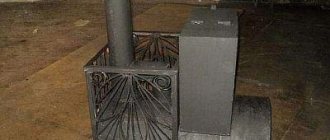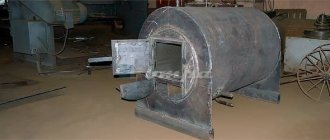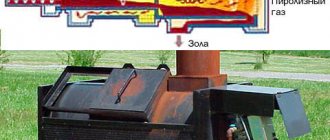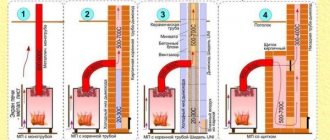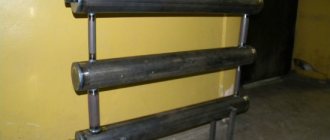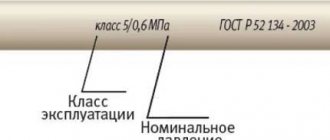Heating devices are an essential element of any water heating system. They are usually the most expensive part. A good opportunity to save money would be to use homemade radiators. They are made from smooth round steel pipes or from profile pipes. The latter option is somewhat more expensive, but allows you to reduce the depth of the device and get a more aesthetic appearance.
The use of a profile pipe for the manufacture of heating registers has a number of features. When starting to work with your own hands or deciding to buy a “homemade” product, you need to carefully weigh the pros and cons. Studying the basic rules by which heating registers are made from a profile pipe will help you avoid mistakes when working independently and will make it possible to make a competent choice of the necessary parameters.
Serpentine registers (S-shaped)
Such registers have become quite popular. The design of these devices is quite simple: there are several sections that are connected by arcs, the diameter of which is close to the sectional ones. Due to this, the hydraulic pressure inside the device is significantly reduced. As a result, the register becomes a single unit, the entire surface of which is working, which significantly increases the efficiency of such devices.
Such heating registers made of smooth pipes usually contain a large amount of carbon. In addition, registers made of other materials can be found on the market: cast iron, alloy or stainless steel.
Main selection criteria
Any specialist has a whole arsenal of tools that help him make the right choice. Each type of pipe has both positive and negative characteristics. Therefore, taking them into account, it is not difficult to find the optimal solution. Much also depends on knowing what heating systems exist and what engineering conditions must be met
Here is a list of basic initial data that must be taken into account when choosing heating pipes:
- Availability of forced or gravity heating system
- Laying method - internal or external
- Complex or simple system configuration.
- System pressure power
- Maximum water temperature
Below is a list of existing options. It will help you decide correctly which pipes to choose.
Sectional registers made of smooth pipes
Sectional registers are in very good demand among owners of private houses. Such devices consist of pipes that are interconnected and closed with plugs. The energy carrier passes through the top pipe, enters the next one, and ultimately ends up in the discharge line. To increase heat transfer, they try to make transitions between sections as close to the edge as possible. Interpipe plugs can be elliptical or flat. The inlet pipe can be made with a flange, thread or welding. The design of sectional registers includes a threaded fitting, to which a special vent is attached to remove air from the system. Pipes for sections can have different diameters (from 25 mm to 40 cm), so choosing the appropriate option is not difficult. Transition pipes usually have a smaller diameter. In addition, one of the most important operating conditions for such installations is the pressure in the system not exceeding 1 MPa.
Best answers
drinker in the thorn bush:
If it is done aesthetically, it is better to use steel registers. If the registers are already mounted, close them behind decorative grilles.
Tech Box:
Smooth pipe circuit for good circulation and large volume of coolant.
Guy from the Future...:
The thermal conductivity of steel is 5 times less than that of aluminum. This means that with the same surface area of the device, the heat transfer of a steel device will be lower than that of aluminum. That is, you will have to make it 5 times larger in size..
Alexander:
The advantage of a smooth register with a large open surface area is that it remains efficient at low coolant temperatures, which cannot be said about modern aluminum ones at temperatures of 40 and below. The disadvantage of a register that has a high heat capacity is that this heat capacity prevents precise regulation. Now it remains to understand the wood-fired boiler and what fraction of the day the return temperature can be no higher than 40C or you have an automated pelletizer with a bunker for several days.
ip:
The best option for hydraulics together with registers is cast iron radiators. They have a slightly larger surface area relative to their volumes and linear dimensions compared to registers. If you need to heat a room without windows and without furniture along the walls, then registers will be good, and if there are windows , then you should put cast iron under them and it will block the heat loss of the room together with a DN50 pipe around the perimeter. The calculation of cast iron comes down to a set of sections in the ratio of two sections per linear meter of street wall for the first floor and one and a half for the second when the first one is heated. Good luck.
Anatoly Bananan:
I think that aluminum heating radiators teplofresh/catalog/alyuminievye-radiatory-otopleniya are best suited for a private home. There are two types of such radiators - cast and extruded. Extrusion radiators are more suitable for heating systems that use antifreeze liquid, since these radiators are more durable and are made of aluminum of fairly high purity.
Marya Lamyr:
I think that decorative stainless steel mesh will suit you perfectly, it is both beautiful and durable! By the way, decorvesta is a good store with similar products!
Pavel Mokov:
The thermal conductivity of steel is less than that of aluminum, so it’s better to take an aluminum radiator, look here tallosplav /catalog/alyuminievye_radiatory/.
Location options
Heating registers, depending on placement options, can be divided into two groups: portable and stationary. Portable systems are quite mobile, and they can be moved absolutely freely - if only there was power. And such systems are usually powered by electricity. Inside portable registers there are usually heating elements of different power, which provide heating of the energy carrier. Such units can be used both in the house and in the garage, at the dacha, at a construction site, etc. Stationary registers are demanding in terms of their location. Firstly, they require permanent mounting, and secondly, they need to be connected to a boiler, which will ensure heating of the coolant and its circulation through the system.
How to make a radiator for your home with your own hands
A properly made battery is easy to use, durable, does not leak, and has a neat appearance. To cope with its construction, you need to go through a number of stages.
Preparation of tools: photo
To make a radiator, you will need the following skills and equipment:
- Metal compounds. To prevent the battery from leaking, the wall material is securely soldered together. This can be done using soldering irons, a welding machine, or a gas torch. Of course, the tools also require welding skills - the seams should turn out beautiful, without slag inclusions and cavities.
Photo 1. Soldering iron ZD-200V, power 40W, power supply - 220 V, .
- Measurements and markings . The work will require rulers, squares, tape measures, and magnets. To install or assemble heavy volumetric batteries on site, you will need a hydraulic level, bubble level, and laser level.
- Metalworking. Working skills and availability of an angle grinder, hammer, chisel, file and other plumbing tools and accessories.
Photo 2. Angle grinder model GWS 660, power consumption 670 W, .Painting materials and tools. A brush, spray, primer, paint, degreaser, thinner will help protect against corrosion and give the product a fresh look.
Photo 3. Universal degreaser, container volume - 5 l, shelf life 36 months, .
A well-equipped workshop will simplify the task and significantly speed up the work, but if some tools are missing, you can rent them or borrow them from friends.
Calculation of heating battery sizes
The main characteristic of a radiator is its ability to transfer heat to the surrounding space. It depends on the properties of the battery walls, the area of the parts, the volume of the coolant and the speed of its circulation.
Designing a battery begins with drawing up a technical specification: required dimensions, heat transfer ability. Radiator design consists of the following steps:
- Calculation of heat loss in a room. The higher and larger the room, the larger the contact area of the radiator with the environment. Each room is unique, as it has its own characteristics of thermal conductivity of walls, quality of glazing, and ventilation. There are reference books that allow you to calculate heat loss, but there are average formulas - add up the heat loss of floors, walls, windows, multiply by a correction factor of 20% - the required power of the radiators is ready.
Material of manufacture
If you make a selection depending on the material of manufacture, then the registers can be classified into the following categories:
- Steel;
- Aluminum;
- Cast iron.
Which heating registers are best to choose? Steel registers became the most common. Their connection to the heating system is carried out by threading or welding. Such devices have good heat transfer and reasonable cost. Aluminum registers are much lighter than steel registers. In addition, they are resistant to corrosion, are made without connecting seams and have good heat dissipation. The main disadvantage of such devices is their very high price. Read also: “What types of heating registers are there – selection, calculation, characteristics.” Registers made of cast iron are connected to the heating system using a flange connection. They are quite easy to install and inexpensive. The disadvantages of cast iron products include low inertia, which significantly reduces the heating time of the registers.
Answers from experts
Tori:
plastic pipes and aluminum radiators.
LegendaSporta:
polypropylene.
mu.rza:
we bought polypropylene ones. each has its pros and cons. Read this, a very informative article about pipes
Vladislav Ushkalov:
Igor Shkurny:
Polypropylene... have less trouble with it... unless of course you have a soldering iron!!!!
Lizard:
I bought a house with completely defrosted metal pipes and cast iron radiators. I chose, consulted, changed to polypropylene and aluminum batteries. I bought one cast iron. and what? It was she who cracked in the very cold (there was no heating, and there was antifreeze in the pipes, but it did not help). I also changed it to aluminum. Further, in the well next to the house there is water supply for five houses, each has its own valve, the pipes are all iron. They rusted like hell. When it burst again, I raised a fuss, collected money from the people, and the local master replaced the filling of the well with polypropylene again. Now we are all calm. So polypropylene is perhaps more reliable. Some people claim that pipes made of polyethylene (very dense) are even more reliable and are not afraid of frost at all, but I don’t know.
Floors:
Iron pipes are 3-5 times cheaper and much more reliable than propylene and plastic. The disadvantage is corrosion of the metal from the inside, which cannot be gotten rid of in any way, but if the water is not drained from the system, then after cutting a 20-year-old pipe, it is as good as new inside (I myself have cut old heating pipes more than once - there is almost zero corrosion inside. And heating devices are more aesthetically pleasing than aluminum and bimetal. USSR cast iron is no longer in fashion, and the material consumption is appalling)))
Sergey Rudin:
Look here: agrosad m /catalog/tverdotoplivnie_kotli_1
Solo:
In a private house AOGV. ) There seem to be no other options.
Andrey:
rephrase the question. A radiator heating system is one thing, but pipes and radiators are a completely separate issue.
Alexander Bonn:
Gas boiler, steel radiators, welded pipe. Energy consumption: 10 sq. m = 1 kW. For a private house, warm floors (1st floor) and radiators are combined. But there must be an emergency heating system (electric or solid fuel).
Alasseia:
question about heating a spherical house in a vacuum, no information about the source of energy supply, no information about the house itself, what would I recommend - a project for heating your bungalow completed by a specialist
F F:
Boilers, boiler equipment. Heating 2 x storey house. : // forum .domostroy /#gazosnabjenie-vodoprovod-otoplenie-konditsionirovanie Gas wall-mounted boiler Heating, plumbing, sewerage for a house or cottage. Heating 2 x storey house.
Which radiators or pipes are better? - it is necessary to rely on the volume of coolant for the correct operation of the boiler! example - 70 sq. wooden house, - they wanted a fan system with aluminum. heating radiators, after calculating the amount of coolant, we chose a register system of pipes.
For a brick house, combine heated floors (1st floor) and radiators, a fan distribution system, and metal-plastic in a screed. Alexander Bonn +++
alexm66:
The question is very general: which is better, a foreign car or a VAZ - for which there is money and opportunity. I think the main criterion is the reliability of the equipment, and a competent installer will be able to make a workable system out of it, but an illiterate one will ruin any “luxury” equipment.
Calculation of the number of ribs
Heating registers must be calculated before purchasing them. The diameter of the pipes is very important: experts believe that pipes with a cross-sectional diameter in the range from 3 cm to 8 cm are suitable for a private house. This decision is determined by the fact that a conventional heating boiler is not capable of producing a larger amount of heat, so too large surfaces will not warm up completely . When making calculations, you need to pay attention to the length of one register rib and the heat transfer per meter of this length. For example, a meter-long pipe with a 6-centimeter cross-section can heat one square meter of area. When calculating the required number of edges, the result must be rounded up. The calculation of the number of heating registers must also take into account the characteristics of the building. For example, if a building has a large number of windows and doors, or if the walls are thin and poorly insulated, then the number of registers can be increased by 20-50%.
Additional design features
Some experts advise welding supports or brackets.
This is not very good, because it makes the structure more massive and not universal. Without welded supports and brackets, it can either be hung on the wall or installed on stands fixed to the floor. In some cases, the owner who dismantled the old sectional batteries. using a radiator key and made a device, he could have made a mistake in calculating the optimal dimensions of a homemade radiator. As a result, the design is not able to heat the air in the room to the required temperature. One way out is to make an additional heater. However, you can improve what has already been made.
To enhance heat transfer, vertical metal plates can be welded. They will also heat up and give off heat. Thanks to them, convection will improve.
These plates can be cut from a metal sheet with a thickness of 1.0-2.0 mm. Their features should be as follows:
- Height - greater than the height of the battery.
- Width - 10-15 cm.
- The presence of 3 cut out squares or rectangles on one side. The dimensions must correspond to the dimensions of the profile pipe.
Such plates are applied to the battery and welded. As for their quantity, the more the better, because the greater the heat transfer becomes.
Selecting a heating battery based on the area of the apartment How hot the heating batteries should be Making a solar battery Heating meters for batteries
Heating register installation
Installing heating registers usually does not require the help of a qualified specialist, but carrying out the operation yourself requires careful preparation. The most important thing is to ensure a reliable connection between the registers and the pipeline. The connection must be able to withstand a load of 10 MPa. When welding, it is very important to maintain good quality. For clarity, you can look at the photo, which shows a diagram of connecting heating registers.
It is best to place registers along the walls. A prerequisite for installing heating devices is maintaining a constant slope, which for registers is 0.05% of its length. In addition, registers should be installed closer to the floor surface.
The efficiency of the device will depend on a large number of factors. For example, a reduced main pipe diameter will increase resistance to the energy carrier, which will affect performance. The most commonly used systems are with the following parameters:
- pipe diameter: 25-160 mm;
- sectional adapters: from 30 mm;
- distance between main pipes: from 50 mm;
- maximum pressure: 10 MPa;
- material: steel.
Step-by-step steps: how to make a heating radiator with your own hands
You can make a heating radiator for a private home yourself. To do this, you will need to first study the instructions and the stages of work. Making a radiator cannot be called difficult, but a lot of time is spent on the preparatory stage and the welding of the structure itself.
At the initial stage of welding, wooden strips or a wrench must be placed under the round pipes - the pipes must fit snugly into the holes made.
In several places, round tubes must be welded to the profile pipe. When making two tacks, make sure that the line between them corresponds to the diameter of the pipe. It is important to secure each end of the jumper well.
Step-by-step welding:
- The jumpers of the profile pipe must be welded so that the structure is positioned vertically.
- Clear profile space.
- Attach plugs.
- Weld the plugs to the base of the radiator.
At the final stage of work, it is necessary to process the welding seams. Having decided on the type of connection, you can drill holes in the finished radiator. Then special couplings are installed on the holes.
Advantages of heating registers
Heating registers have a number of advantages:
- possibility of using an individual drawing;
- The coolant can be not only water, but also heated steam;
- connecting the heating register to the system is extremely simple;
- excellent for heating large buildings because they have very good heat transfer;
- They're pretty cheap.
A homemade heating register is shown in the video: Conclusion Registers have already become good competitors to conventional heating radiators. Do-it-yourself heating registers allow you to save a lot, and these designs can work even in rooms with an aggressive environment.
Which metal is better
To begin with, we note that structures of this kind can be intended both for heat transfer, performing the function of radiators, and for heat intake, when a tubular register is mounted directly in the combustion chamber of a boiler or furnace.
Plus, in some models, instead of a coolant liquid, heated gas is used, for example, a radiator chimney pipe.
- Steel pipes for heating radiators are deservedly considered leaders in this market sector . Of course, the heat transfer of steel is not as high as that of aluminum or copper; it is susceptible to corrosion and requires regular maintenance. But these shortcomings are more than compensated for by the affordable price, as well as a wide range of types and sizes. In addition, it is much easier to weld ordinary ferrous metal than non-ferrous metal.
- Stainless steel is used extremely rarely for such structures . Apart from the fact that its cost, to put it mildly, is far from budget, argon welding is used for soldering stainless steel, and not every professional welder can work with it.
Types and characteristics of tubular radiators
From all of the above, it becomes clear that in this case there is practically no alternative to steel pipes. Although the appearance of structures welded by yourself is very mediocre, they are quite suitable for a garage, greenhouse or cottage, plus the instructions for self-assembly are not complicated.
Battery diagram with electric heating element.
Types of homemade tubular radiators
Homemade designs of this kind are often made serpentine or register. The configuration of the first is included in the name. The metal pipe is bent in the form of a snake, after which connecting pipes and, in some cases, fastening strips are welded to it.
Standards for the production of registers.
A one-piece bent radiator naturally has significant advantages over welded structures. But to bend a steel pipe, you need a special pipe bender or at least a gas torch. Plus the pipe diameter, as a rule, does not exceed 50 mm. Therefore, for more powerful systems it is common to use register constructs.
There are no restrictions on the diameter of the radiator tube in the register system. Most often, smooth round pipes from 32 to 150 mm in diameter are used here.
Sections can be connected in two ways - in a thread or in the form of a column. A thread connection, in fact, differs from a coil only in the presence of connecting pipes. Otherwise, it's still the same consistent snake.
The pipes in the column are connected in parallel. That is, horizontally mounted sections of larger diameter are connected to each other by vertical couplers on both sides. This is somewhat reminiscent of a standard factory radiator, only turned on its side.
Such homemade registers can be connected to both one-pipe and two-pipe systems. The type of system is not reflected in the technical characteristics. Due to their large diameter and minimal hydraulic resistance, such registers work best in heating systems with natural coolant flow.
